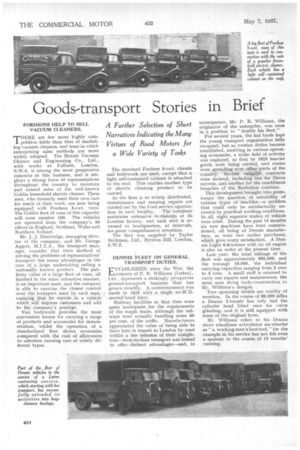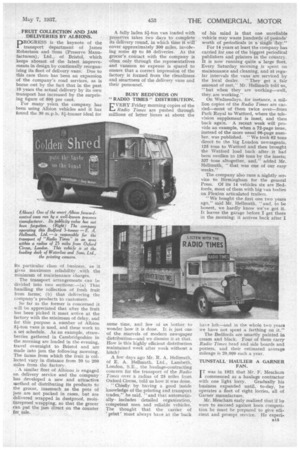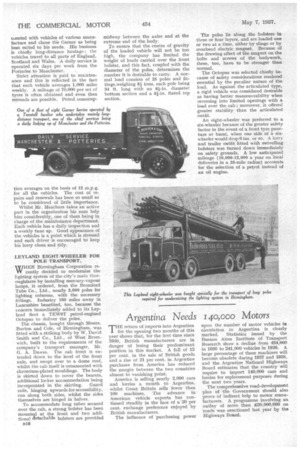Goods-transport Stories in Brief
Page 48

Page 49

Page 50

If you've noticed an error in this article please click here to report it so we can fix it.
A Further Selection of Short Narratives Indicating the Many Virtues of Road Motors for 'a Wide Variety of Tasks
FORDSONS HELP TO SELL VACUUM CLEANERS.
THERE are few more highly competitive fields than that of marketing vacuum cleaners, and none in which enterprising sales methods are more widely adopted. The British Vacuum Cleaner and Engineering Co., Ltd., with works at Fulham, London, S.W.6, is among the most progressive concerns in this business, and it employs a strong force of representatives throughout the country to maintain and extend sales of the well-known Goblin household electric cleaner. These men, who formerly used their own cars for much of their work, are now being equipped with Fordson 5-cwt. vans. The Goblin fleet of vans of this capacity will soon number 100. The vehicles are operated from the company's 36 offices in England, Scotland, Wales and Northern Ireland.
Mr. J. J. Hanbridge, managing director of the company, and Mr. George
Aggett, the transport manager, consider that their method of solving the problems of representatives' transport has many advantages in the case of a large undertaking selling a nationally known product. The publicity value of a large fleet of vans, all finished in the same attractive manner, is an important asset, and the company is able to exercise the closest control over the transport used by each man, ensuring that he travels in a vehicle which will impress customers and add to the company's prestige.
Van bodywork provides the most convenient means for carrying a range of products and accessories for demonstration, whilst the operation of a standardized fleet shows economies compared with the cost of allowances to salesmen running cars of widely different types. The standard Fordson 5-cwt. chassis and bodywork are used, except that a light self-contained cabinet is attached to the roof. This enables another type of electric cleaning product to be carried.
As the fleet is so widely distributed, maintenance and running repairs are carried out by the Ford service.oganization in each locality. The 'conipany maintains extensive wcikshoPs at its London factory, and each unit is returned to headquarters, at intervals, for imore comprehensive attention.
The fleet was supplied by Taylor Beckman, Ltd., Brixton Hill, London, S.W.2.
DENNIS FLEET ON GENERAL TRANSPORT DUTIES.
L'STABLISHED since the War, the 1-a concern of P. R. Williams (Luton). Ltd., represents a strikingly prosperous general-transport business that has grown steadily. A commencement was made in 1919 with a single ex-W.D. second-hand lorry.
Railway facilities at that time were quite inadequate for the requirements of the staple trade, although the railways were actually handling some 80 per cent, of the traffic. Manufacturers appreciated the value of being able to have hats in transit to London by road within a few minutes of their completion—door-to-door transport was bound to offerdistinct advantages—and, in consequence, Mr. P. R. Williams, the originator of the enterprise, was soon in a position to "double his fleet." For several years, the hat trade kept the young transport organization fully occupied, but as routine duties became established, resulting in various operating economies, a wider field of activity was explored, so that by 1925 heavier goods were being carried, and routes were spreading over other parts of the country. 'Several valnable, contracts were secured, including one for Dec,ca records, and, another for the constituent branches of the Radiatibn combine.
This development brought into prominence. the question of suitability of various types of mach?ne—a problem that could only be satisfactorily answered by practical working conditions. In all, eight separate makes of vehicle were tried. During the past 14 months six new machines have been commissioned, all being of Dennis manilla/4ture, as were two earlier purchases, which gave every satisfaction. A Dennis Light 6-8-tonner with an oil engine is also on order at the present time.
Last year, the total mileage of the fleet was approximately 500,000, and the tonnage 16,000, the individual carrying capacities ranging from 2 tons to 5 tons. A small staff is retained to carry out repairs and maintenance, the same men doing body-construction to Mr. Williams's designs.
Two operating details are worthy of mention. In the course of 89,000 nines a Dennis 2-tonner has only had the cylinder head lifted " once for valve grinding, and it is still equipped with some of the original tyres.
Mr. Williams refers to his Dennis short wheelbase articulated six-wheeler as" a working man's best tool," for the example in his service has not felt even a spanner in the course of 12 months' running. FRUIT COLLECTION AND JAM DELIVERIES BY ALBIONS.
PROGRESS is • the keynote of the transport department of James Robertson and Sons (Preserve Manufacturers), Ltd., of Bristol, which keeps abreast of the latest improvements in design by continually reorgans izing its fleet of delivery vans: Due to this care there has been an expansion of the company's road services, as is borne out by the fact that in the past 10 years the actual delivery by its own transport has increased by the surprising figure of 500 per cent.
For many years the company has been using Albion vehicles and it has found the 30 m.p.h. 51-tonner ideal for
its particular class of business, as it gives maximum reliability with the minimum of maintenance Charges.
The transport arrangements can be divided into two sections:—(a) That handling the collection of fresh fruit from farms; (b) that delivering the company's products to customers.
So far as the former is concerned it will be appreciated that after the fruit has been picked it must arrive at the factory with the minimum of delay, and for this purpose a number of Albion 5i-ton vans is used, and these work to a set schedule. As an example, strawberries gathered in Cambridgeshire in the morning are loaded in the evening, travel overnight to Bristol and are made into jam the following morning. The farms from which the fruit is collected vary in distance from 20 to 200 Miles from the factory.
'A similar fleet of Albions is engaged on delivery service and the company has developed a new and attractive method of• distributing its products to the grocer, inasmuch as the pots of jam are not packed in cases, but are delivered wrapped in dustproof, moistUreproof wrapping, so that the grocer can put the jam direct on the counter for sale. A fully laden 51-ton van loaded with preserves takes two days to completeits delivery round, in which time it will cover approximately 300 miles, involving some 40 to 50 deliveries. As the grocer's contact with the company is often only through the representatives and vanmen no expense is spared to ensure that a correct impression of the factory is formed from the cleanliness and smartness of the delivery vans and their personnel.
BUSY BEDFORDS ON "RADIO TIMES" DISTRIBUTION.
VERY Friday morning copies of the Radio Times are pushed through millions of letter boxes at about the
same time, and few of us bother to wonder how it is done. It is just one of the marvels of modern newspaper distribution—and we dismiss it at that. How is this highly efficient distribution maintained week after week without a hitch?
A few days ago Mr. R. A. Hellmuth, of E. A. Hellrnuth, Ltd., Lambeth, London, S.E., the haulage-contracting concern for the transport of the Radio Times over a radius of 25 miles from Oxford Circus, told us how it was done.
• " Chiefly by having a good inside knowledge of the printing and transport trades," he said, "and that automatically. includes detailed organization, competent men and reliable vehicles. The thought that the carrier of print' must always have at the -back of his mind is that one unreliable vehicle may waste hundreds of pounds' worth of periodicals in a single day."
For 14 years at least the company has carried for one of the biggest periodical publishers and printers in the country. It is now running quite a large fleet, Every Saturday morning is spent on maintenance and cleaning, and at regular intervals the vans are serviced by the local dealer. "They get a fair amount of rest," Mr. Hellmuth told us, 'but when they are working—well, they are working."
On Wednesdays, for instance, a million copies of the Radio Times are carried—most of them twice over—from Park Royal to Watford, where the television supplement is inset, and then back again. A recent week will provide an example, when a 72-page issue, instead of the more usual 96-page number, was published. "We took 62 tons direct to the big London newsagents, 125 tons to Watford and then brought the Watford load back after it had been swollen to 150 tons by the insets; 337 tons altogether, and," added Mr. Hellmuth, "that was one of our easy weeks."
The company also runs a nightly service to Birmingham for the general Press. Of its 14 vehicles six are Bedfords, most of them with big van bodies on Flexion articulated trailers,
"We bought the first one two years ago," said Mr. Hellmuth, "and, to be honest, we hardly know we've got it. It leaves the garage before I get there in the morning; it arrives back after I have left—and in the whole two years we have not spent a farthing on it."
The •Bedfords are smartly painted in cream and black. Four of them carry Radio Times head and side boards and posters, and their estimated average mileage is 20,000 each a year.
TUNSTALL HAULIER A GARNER
IT was in 1921 that Mr. F. Meacham commenced as a haulage contractor with one light lorry. Gradually his business expanded until, to-day, he operates a fleet of eight lorries, all of Garner manufacture.
Mr. Meacham early realized that if he were to succeed against keen competition he must be prepared to give efficient and prompt service. He experi
it.ented with vehicles of various maimfacture and chose the Gainer as being best suited to his needs. His business is chiefly long-distance haulage ; the vehicles travel to all parts of England, Scotland and Wales. A daily service is operated six days per week from the Potteries to Manchester.
Strict attention is paid to maintenance and this is reflected in the fact that each vehicle averages 1,000 miles weekly. A mileage of 70,000 per set of tyres is often obtained and even then retreads are possible. Petrol consump tion averages on the basis of 12 m.p.g. for all the vehicles. The cost of repairs and renewals has been so small as to be considered of little importance.
Whilst Mr. Meacham takes an active part in the organization his sons help him considerably, one of them being in charge of the maintenance department. Each vehicle has a daily inspection and a weekly tune up. Good appearance of the vehicles is a point which is stressed and each driver is encouraged to keep his lorry clean and tidy.
LEYLAND EIGHT-WHEELER FOR POLE TRANSPORT. Wili.EN Birmingham Corporation reVV cently decided to modernize the
lighting system of the city's main thoroughfares by installing mercury-vapour lamps, it ordered, from the Bromford Tube Co., Ltd., nearly 3,000 poles for lighting columns, with the necessary fittings. Industry 100 miles away in Lancashire benefited, too, because the concern immediately added to its Leyland fleet a TEW9T petrol-engined Octopus to deliver the poles.
The chassis, bought through Messrs.
Burton and Cole, of Birmingham, was fitted with a striking body by W. David Smith and Co., Ltd., of West Bromwich, built to the requirements of the company's transport manager, Mr. G. A. Dawes. The cab front is extended down to the level of the front axle, and swept over to a dome roof, whilst the cab itself is ornamented with chromium-plated mouldings. The body is skirted down to cover the bearers, additional locker accommodation being incorporated in the skirting. Guard rails, hinging upwards for accessibility, run along both sides, whilst the sides themselves are hinged in halves.
To accommodate long tubes secured over the cab, a strong bolster has been mounted at the front and two additional detachable bolsters are provided B16 midway between the axles and at the extreme end of the body.
To ensure that the centre of gravity of the loaded vehicle will not be too high, the company has limited the weight of loads carried over the front holster, and this fact, coupled with the diameter of the poles, determines the number it is desirable to carry. A normal load consists of 25 poles and fittings,weighing 81tons, each pole being 34 ft. long with an 8a-in. diameter bottom section and a 54-in. fluted top section. The poles lie along the bolsters in three or four layers, and are loaded one or two at a time, either by slings or by overhead electric magnet. Because of the drawing effect of the magnet on the bolts and SUMS of the bodywork, these, too, have to be stronger than normal.
The Octopus was selected chiefly because of safety considerations rendered essential by the peculiar nature of the load. As against the articulated type, a rigid vehicle was considered desirable as having better manceuvrability when reversing into limited openings with a load over the cab ; moreover, it offered greater stability than the articulated outfit.
An eight-wheeler was preferred to a six-wheeler because of the greater safety factor in the event of a front tyre puncture or burst, when one side of a sixwheeler would drop 6 ins. or so. A lorry and trailer outfit fitted with swivelling bolsters was turned down immediately on safety grounds. A low anticipated mileage (10,000-12,000 a year on local deliveries in a 25-mile radius) accounts for the selection of a petrol instead of an oil engine.




















































































